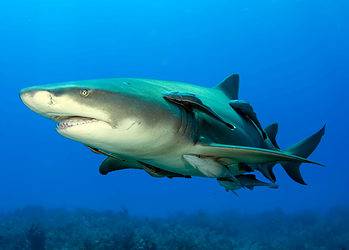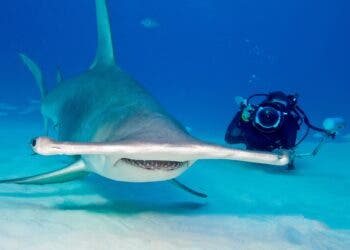We now have shark vision: researchers have built a camera that approximates how sharks see.

Underwater, the world looks mostly blue to human eyes. But the sheer diversity of marine wildlife means there’s always something extraordinary to find. For David Gruber, that something is fluorescent creatures. In 2015, he found a ‘glowing’ neon red turtle, making headlines all over the world. He’s found more than180 fish species in 2014, as well as dozens of fluorescent coral species. But he doesn’t just want to discover things, he wants to understand them – why these creatures evolved in such a unique way – so he and his colleagues built a “shark-eye” camera to simulate how fluorescent sharks appear to each other. Yes, in case you didn’t know, there are also fluorescent sharks.
Fluorescent Sharks
Don’t expect the fluorescent sharks to glow brightly. Unlike the firefly, they don’t generate their own light. They have specially adapted molecules in their skin which absorb specific wavelengths of light and emit that light in other wavelengths. As is the case with other marine fluorescent animals, they absorb blue light and transform it into green, red, or orange.
The glow is hard or impossible to notice with human eyes. At most, we could see an eerie greenish glow and that’s pretty much it. But for sharks this probably is an outstanding feature. So Gruber set out to understand how sharks see.
He started by dissecting shark eyes and learned that they are monochromats. This means that unlike humans, who construct the colors from three pigments, sharks use just one pigment. It makes a lot of sense when you think about it.
“The ocean is this huge blue filter, and it becomes more perfectly blue as you go deeper,” Gruber tells National Geographic. If there aren’t any other colors of light to see, why bother?
The study he published documents fluorescence in two species: chain catshark (Scyliorhinus rotifer) and the swell shark (Cephaloscyllium ventriosum). The swell shark is covered by small, bright green fluorescent spots over much of its body, but females have a distinctive “face mask” of glowing spots. Meanwhile, the chain catshark chain has an alternating light and dark fluorescent pattern but no spots. The pattern is stronger in females, but this time there is no face mask. These sharks are generally nocturnal and solitary creatures, but not much is known about their behavior. However, it seems plausible that fluorescence is an important feature for them, likely for finding potential mates.
“But they might also be using biofluorescence to communicate in a way we haven’t thought of,” says Gruber. “It reminds me of when researchers first tuned in to the high frequency of bat sounds, and they discovered all this hidden chatter. They had to then figure out what it meant.”
They then conducted a review of the literature, to see if other species exhibited similar features. The team found that this ability developed independently at least three times among the sharks and rays, in the distantly related families Urotrygonidae (American round stingrays), Orectolobidae (wobbegongs), and Scyliorhinidae (catsharks). Because it emerged in such distant families and in so different ways, it seems that fluorescence is quite a valuable trait and can be achieved in more than one way. Furthermore, it shows that there are likely other fluorescent sharks just waiting to be discovered.
Ultimately, they used what they learned about this feature to create a camera with “shark vision”. It’s “a very high-resolution movie camera,” Gruber says, fitted with filters that simulate what a shark would see. The results are what you can see above.
Now the real question is, if a shark sees something like this, what does it mean for it? What information can it draw based on these fluorescent patterns? Does the extra light serve some specific purpose? Is it simply to find other members of its species? These are all questions researchers hope to answer in the future.
But not everyone is convinced. Nathan Hart, a biologist at Macquarie University in New South Wales, Australia, who studies shark vision, believes fluorescence has little importance. He told the Atlantic:
“It makes perfect sense if you think about life in the blue ocean,” Gruber says. “Why wouldn’t they come up with a way to make their world richer in texture?”
But being able to see as humans see is a great achievement in itself. It helps us understand these magnificent predators which have been around for hundreds of millions of years – and which we’re quickly driving to extinction.
“This work forces us to take a step out of the human perspective and start imagining the world through a shark’s perspective,” says Gruber. “Hopefully it will also inspire us to protect them better,” he says, noting that an estimated 100 million sharks are killed by people each year.






